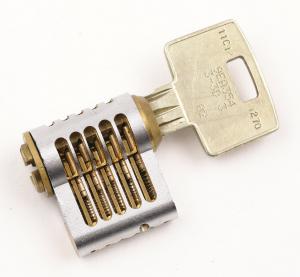How Do Cylinder Locks Work?
Some of the most popular home locks feature preinstalled lock cylinders inside. One of the main advantages of cylinder locks is their easy accessibility in case they require repair work. Replacing some screws or pins is cheap and done without any extra hassle or the need to remove the bolt of the door. If you are currently in the market for some new cylinder locks, or you want to learn how cylinder locks work, what are the different cylinder lock types, or learn about their history, read on.
Brief History of Cylinder Locks
After the resounding success recorded in Britain by Chubb, Barron, and Braham with their new lock models, Yale took cylinder locks one step forward, improving their features, patenting a new model, and introducing it to the American public in 1865. The previous patent locks received the name of “cylinder lock” and it was initially developed by Linus Yale senior and improved by Linus Yale Junior, completely revolutionizing the world of door locks. Cylinder locks and the numerous alterations brought to them over the years continue to enjoy a lot of popularity throughout the world today, and they are found on a variety of different doors, padlocks, and gates. Today, this modern lock mounted on the surface of the door is most common on apartment doors as well as the front doors of houses.
Find Our What Are Cylinder Locks And How Cylinder Locks Work
Primarily, you will see two distinct types of locks on most homes, namely, key locks part of deadbolt locks and doorknob locks. Key locks rely on cylinders placed alongside the middle section of the lock, running all the way into the door. Once these doors are unlocked or locked, a series of small parts are triggered and begin to work simultaneously with the keys. This will help the locks function accurately. The tangs are important components of these locks and they are found inside the cylinders' centers, sitting in this position when the doors are not locked. Nonetheless, once the doors are into their locked position, the tangs will remain partly in the interior and partly in the exterior of the cylinders.
 The Role Of Springs, Pins, and Keys
The Role Of Springs, Pins, and Keys
Cylinder locks are designed in such a way to ensure that only a certain key will be able to lock and unlock lock types. This means that only the respective key will be able to turn the cylinder. Inside the cylinder, we can see a number of pins of various heights. Moreover, springs are used to keep the respective pins inside, in their tight positions. The pins on the upper side of the cylinder are responsible for preventing the cylinder from turning when the cylinder is locked. Once someone unlocks the door, the pins are automatically released, making the cylinder turn.
The notches you can see on the keys used for cylinder locks are meant to ensure that every pin so will reach its correct height and position. When a gap between upper and lower pins exists, the cylinder will initiate its movement and enable the mechanism to unlock the door. At the same time, when using the wrong key, the missing pattern needed to trigger the movement of the pins will be missing. This means the door will remain in its locked position and prevent the key from turning.
Types Of Cylinder Locks To Choose From
If you are in the market for new cylinder locks for one reason or the other, a good starting point, besides knowing how cylinder locks work, is to familiarize yourself with the different types of cylinder locks: profile cylinder locks, mortise locks, rim cylinders, deadbolt, key in knob or key in lever options. Let's see how each of these works and what separates them from one another.
Profile Cylinder Locks
These models are more popular in European countries, but some American households also use them as well. However, they cannot be used on storm doors and they are normally sold in the teardrop or oval shape, featuring a middle cam responsible for that manipulating the interior and the exterior of the lock.
Mortise Cylinder Locks
These locks feature round cylinders that protrude the lock's body with the help of screws. Some models may require the fitting of spaces to help the cylinder flush simultaneously with the lock. You can buy these in the standard form for keyways or invest in models with cores that can be replaced.
Rim Cylinder Locks
Mostly used on exit doors and other similar devices used for exiting a room or building, rim cylinder locks resemble mortise models. However, what separates them is their end tailpiece. You can buy these in both interchangeable or standard keyway models.
Deadbolt Cylinder Locks
One of the most popular types of cylinder locks used on the majority of American homes is the deadbolt cylinder locks, whether in its single or double cylinder format. A key is necessary to make the cylinder rotate and further retract the deadbolt. The interior of the deadbolt can be manipulated with the help of a thumb turn or a key.
- Single-cylinder locks can be easily operated in their locked and unlocked position with the help of a key used on the outside of a door. They do not require the use of a key to lock and unlock the door on the inside.
- Double-cylinder locks require a key to be used on both the outside and the inside.
Key in Knob Cylinder Locks
Lever or key in knob cylinder locks are found on standard knob locks and lever sets. The role of the cylinder is to hold the part of the lock where the key will be inserted. Knobs and lever sets that rely on interchangeable cores are built in a different manner and they are not compatible with made standard cylinders.
Now that you know the basics of what cylinder locks are and how they work, buying new ones or having the old ones replaced should go faster and smoother. For further assistance or immediate emergency lock repair or installation needs, get in touch with our expert cylinder lock repairs near me service today.
